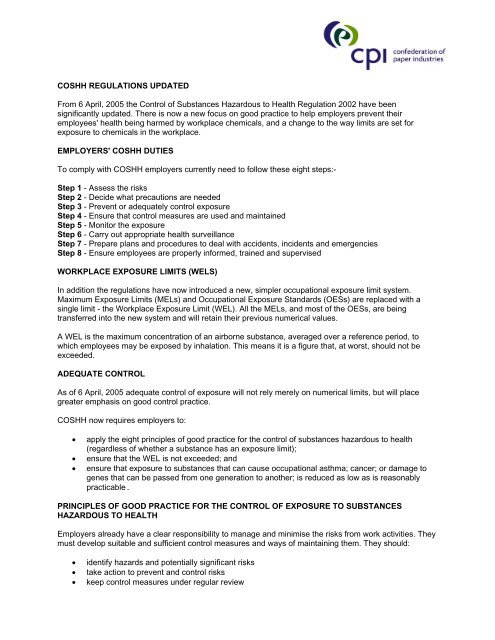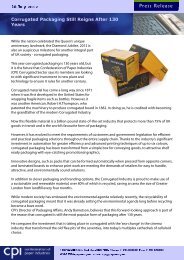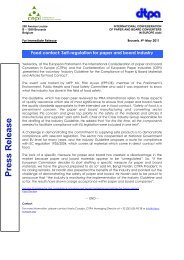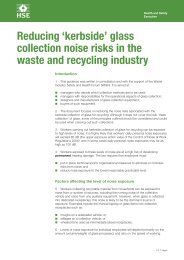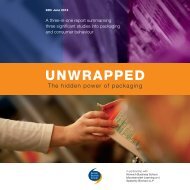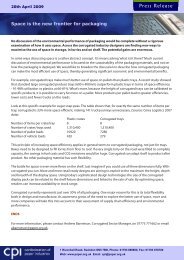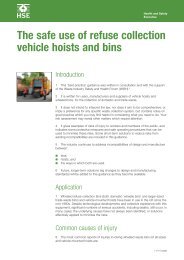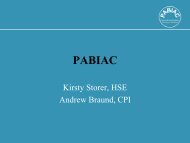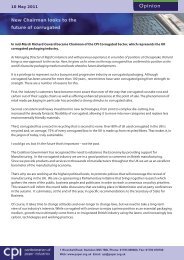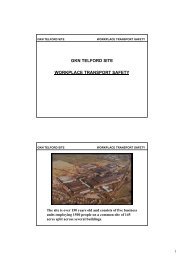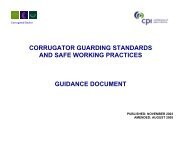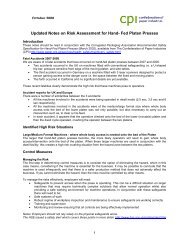COSHH Regulations Update
COSHH Regulations Update
COSHH Regulations Update
Create successful ePaper yourself
Turn your PDF publications into a flip-book with our unique Google optimized e-Paper software.
<strong>COSHH</strong> REGULATIONS UPDATED<br />
From 6 April, 2005 the Control of Substances Hazardous to Health Regulation 2002 have been<br />
significantly updated. There is now a new focus on good practice to help employers prevent their<br />
employees' health being harmed by workplace chemicals, and a change to the way limits are set for<br />
exposure to chemicals in the workplace.<br />
EMPLOYERS' <strong>COSHH</strong> DUTIES<br />
To comply with <strong>COSHH</strong> employers currently need to follow these eight steps:-<br />
Step 1 - Assess the risks<br />
Step 2 - Decide what precautions are needed<br />
Step 3 - Prevent or adequately control exposure<br />
Step 4 - Ensure that control measures are used and maintained<br />
Step 5 - Monitor the exposure<br />
Step 6 - Carry out appropriate health surveillance<br />
Step 7 - Prepare plans and procedures to deal with accidents, incidents and emergencies<br />
Step 8 - Ensure employees are properly informed, trained and supervised<br />
WORKPLACE EXPOSURE LIMITS (WELS)<br />
In addition the regulations have now introduced a new, simpler occupational exposure limit system.<br />
Maximum Exposure Limits (MELs) and Occupational Exposure Standards (OESs) are replaced with a<br />
single limit - the Workplace Exposure Limit (WEL). All the MELs, and most of the OESs, are being<br />
transferred into the new system and will retain their previous numerical values.<br />
A WEL is the maximum concentration of an airborne substance, averaged over a reference period, to<br />
which employees may be exposed by inhalation. This means it is a figure that, at worst, should not be<br />
exceeded.<br />
ADEQUATE CONTROL<br />
As of 6 April, 2005 adequate control of exposure will not rely merely on numerical limits, but will place<br />
greater emphasis on good control practice.<br />
<strong>COSHH</strong> now requires employers to:<br />
• apply the eight principles of good practice for the control of substances hazardous to health<br />
(regardless of whether a substance has an exposure limit);<br />
• ensure that the WEL is not exceeded; and<br />
• ensure that exposure to substances that can cause occupational asthma; cancer; or damage to<br />
genes that can be passed from one generation to another; is reduced as low as is reasonably<br />
practicable.<br />
PRINCIPLES OF GOOD PRACTICE FOR THE CONTROL OF EXPOSURE TO SUBSTANCES<br />
HAZARDOUS TO HEALTH<br />
Employers already have a clear responsibility to manage and minimise the risks from work activities. They<br />
must develop suitable and sufficient control measures and ways of maintaining them. They should:<br />
• identify hazards and potentially significant risks<br />
• take action to prevent and control risks<br />
• keep control measures under regular review
To be effective in the long term, control measures must be practical, workable and sustainable. The<br />
principles of good control are now part of the <strong>COSHH</strong> <strong>Regulations</strong> - they appear in Schedule 2A, aligned<br />
with Reg. 7(7).<br />
Employers who do not follow these principles will not be properly protecting their employees. They are to:<br />
(a) Design and operate processes and activities to minimise emission, release and spread of substances<br />
hazardous to health<br />
(b) Take into account all relevant routes of exposure<br />
(c) Control exposure by measures that are proportionate to the health risk<br />
(d) Choose the most effective and reliable control options which minimise the escape and spread of<br />
substances hazardous to health<br />
(e) Where adequate control of exposure cannot be achieved by other means, provide, in combination with<br />
other control measures, suitable personal protective equipment<br />
(f) Check and review regularly all elements of control measures for their continuing effectiveness<br />
(g) Inform and train all employees on the hazards and risks from the substances with which they work and<br />
the use of control measures developed to minimise the risks<br />
(h) Ensure that the introduction of control measures does not increase the overall risk to health and safety<br />
Guidance on applying the principles was also published on 6 April to help employers. In the coming<br />
months case studies illustrating good practice will be published on HSE's <strong>COSHH</strong> website.<br />
http://www.hse.gov.uk/coshh/index.htm<br />
Good practice advice on controlling chemicals is available at HSE's <strong>COSHH</strong> Essentials website<br />
http://www.coshh-essentials.org.uk/<br />
New versions of the <strong>COSHH</strong> Approved Code of Practice; EH40 (the list of exposure limits); and the brief<br />
guide to <strong>COSHH</strong> leaflet is available from HSE Books (http://www.hsebooks.co.uk/) or telephone 01787<br />
881 165, fax 01787 313995 The brief guide is also available on the HSE website at:<br />
http://www.hse.gov.uk/pubns/indg136.pdf<br />
Information on <strong>COSHH</strong> is available on the Amicus H&S website at:<br />
http://www.amicustheunion.org/main.asp?page=2070<br />
WHAT SHOULD EMPLOYERS’ BE DOING?<br />
• ensure you involve your Safety Representatives in the <strong>COSHH</strong> assessment, so that no substance<br />
is used without having first been fully assessed<br />
• take copies of <strong>COSHH</strong> assessments and records of monitoring, including the results of local<br />
exhaust ventilation tests<br />
• check that measures to first prevent and then control exposure are introduced<br />
• ensure that you provide information and training in the risks and alternative means of working with<br />
substances hazardous to health.


